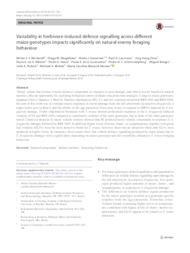Variability in herbivore-induced defence signalling across different maize genotypes impacts significantly on natural enemy foraging behaviour.
Variability in herbivore-induced defence signalling across different maize genotypes impacts significantly on natural enemy foraging behaviour.
Autoria: MICHEREFF, M. M.; MAGALHÃES, D. M.; HASSEMER, M. J.; LAUMANN, R. A.; ZHOU, J.-J.; RIBEIRO, P. E. de A.; VIANA, P. A.; GUIMARAES, P. E. de O.; SCHIMMELPFENG, P. H. C.; BORGES, M.; PICKETT, J. A.; BIRKETT, M. A.; MORAES, M. C. B.
Resumo: 'Smart' plants that release volatile defence compounds in response to pest damage, and which recruit beneficial natural enemies, offer an opportunity for exploiting biological control in future crop protection strategies. Using six maize genotypes, Zapalote Chico (?landrace?), Mirt2A, Sintético Spodoptera (SS), L3, and two commercial hybrids BRS 4103 and BRS 1040, the aim of this work was to evaluate maize responses to larval damage from the fall armyworm Spodoptera frugiperda, a major maize pest in Brazil, and the ability of the egg parasitoid Telenomus remus to respond to HIPVs induced by S. frugiperda damage. Y-tube olfactometer bioassays with T. remus showed preferential responses to the S. frugiperda-induced volatiles of SS and BRS 4103 compared to constitutive volatiles of the same genotypes, but to none of the other genotypes tested. Chemical analysis of maize volatile extracts showed that SS produced more volatile compounds in response to S. frugiperda damage, followed by BRS 4103. In addition, higher levels of mono, homo-, or sesquiterpenes, together with green leaf volatiles (GLVs) were the most attractive blend for T. remus; however, there was no attraction when only GLVs were produced in higher levels. In summary, these results show that volatile defence signalling produced by maize plants due to S. frugiperda damage varies significantly depending on maize genotype and this variability influences T. remus foraging behaviour.
Ano de publicação: 2019
Tipo de publicação: Artigo de periódico
Unidade: Embrapa Milho e Sorgo
Palavras-chave: Genótipo, Inimigo Natural, Milho
Observações
1 - Por padrão são exibidas publicações dos últimos 20 anos. Para encontrar publicações mais antigas, configure o filtro ano de publicação, colocando o ano a partir do qual você deseja encontrar publicações. O filtro está na coluna da esquerda na busca acima.
2 - Para ler algumas publicações da Embrapa (apenas as que estão em formato ePub), é necessário ter, no celular ou computador, um desses softwares gratuitos. Sistemas Android: Google Play Livros; IOS: iBooks; Windows e Linux: software Calibre.
Acesse outras publicações
Acesse a Base de Dados da Pesquisa Agropecuária (BDPA) para consultar o acervo completo das bibliotecas da Embrapa.

